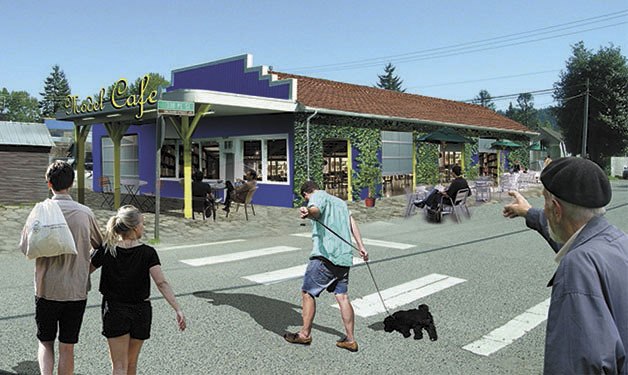By Kira Clark
Staff Intern
Instead of writing papers, architecture students at the University of Washington completed their senior requirements by working to solve problems in Fall City.
Thirteen students spent 12 weeks this spring talking with community members, brainstorming changes and proposing a series of enhancements through a program called StoreFront Studio.
For Fall City, the university students designed additions to open spaces, a farmer’s market, pedestrian bridges, bathrooms and renovations to many existing businesses.
Fall City residents appreciate the students’ efforts, but question whether some of these ideas fit in their community.
Brainstorms
UW Professor Jim Nicholls leads StoreFront Studio classes across the state, visiting small communities including Roslyn and Carnation.
According to Nicholls, the program gives undergraduates a chance to work within a community, listen to real concerns and, with luck, inspire local residents to implement their changes.
The Fall City project began with a kick-off meeting held at the Fall City Masonic Lodge. Forty people from the community attended, and students sat and asked questions about what is needed here.
“It was us listening and them talking to us about their dreams of the community,” Nicholls said.
Students were split up into four groups assigned to work on different parts of Fall City.
Student Bryn Kepler’s group worked on the west end of Fall City, coming up with a pedestrian bridge and walkway.
“We brainstormed ways that we thought that area could be improved, like adding bathrooms and a painting alleyway.”
But to add the public bathroom, Kepler proposed taking out a business—Fall City’s Smoeko Plus tobacco shop. The student reasoned that the shop “is really in a public campus zone…. It would be more sustainable.”
Using a computer program, students made digital pictures of what Fall City could be.
“This is just an envisioning process,” said program assistant Stacy Cannon. “We are providing an image which can be a catalyst to change.” She hopes that locals will use their own resources to make changes happen.
Fall City character
During a series of open houses throughout the project, students showed their work to residents and asked for feedback. Kepler wanted to add lights down main street. But at community meetings, she learned that some residents do not want to add lights because it would change the character of downtown.
Kepler believes that everyone in the community is attached to something in Fall City, and that there is no right or wrong answer about changing the town.
Frank Schumacher, master of the Masonic Lodge, said it is hard to see change. He’s lived in Fall City for 36 years and still feels like a relative newcomer compared with families who have lived here for generations. He loves the Fall City he grew up in, and is uncomfortable with big change brought in from the outside. The ideas “do change the character of the town, not necessarily in a good or bad way,” said Schumacher, who attended the open house.
One student proposal would have replaced the Model Garage with a café. Bad idea, say Laurie Clark and Peggy Beals, who work and live in Fall City.
“A lot of people rely on the Model Garage. I don’t understand why they would want to change it,” said Clark.
“If you took out the Model Garage, this town would have a breakdown. That might be a big problem,” said Beals.
Other proposals would require Fall City to bring in sewers, a major undertaking that some property owners resist.
Resident Laurie Hauglie was more optimistic, saying it got “local folks really excited about stepping up.”
“StoreFront gave us some different ways of looking at the buildings,” she said. “It’s great to see it from another perspective… It was nice to think outside the box.”
• You can learn more about the StoreFront Studio program at www.storefrontstudio.org.

Above, university architecture students proposed adding a seasonal farmers market to a lot in downtown Fall City.
Below, the lot as it exists.


Above, a garage building, envisioned by students as a flower shop and cafe.
Below, the current lot.


Above, UW professor Jim Nicholls talks with his students before they make their final presentation to Fall City Community members.


